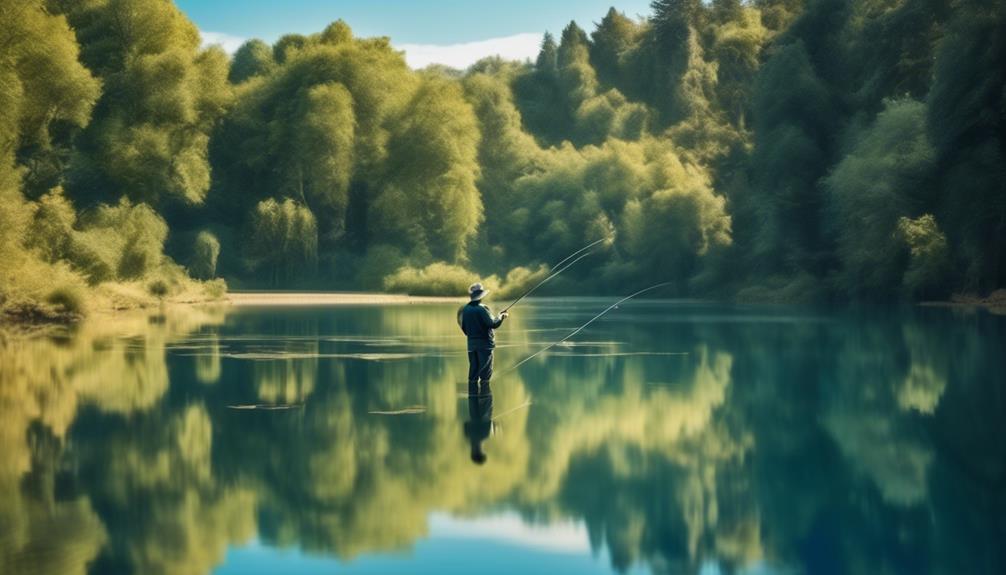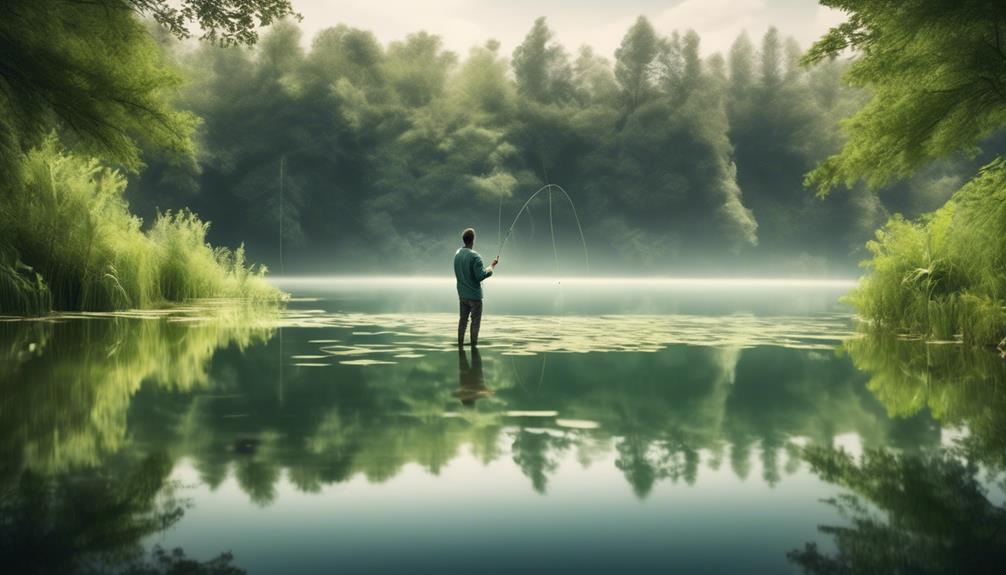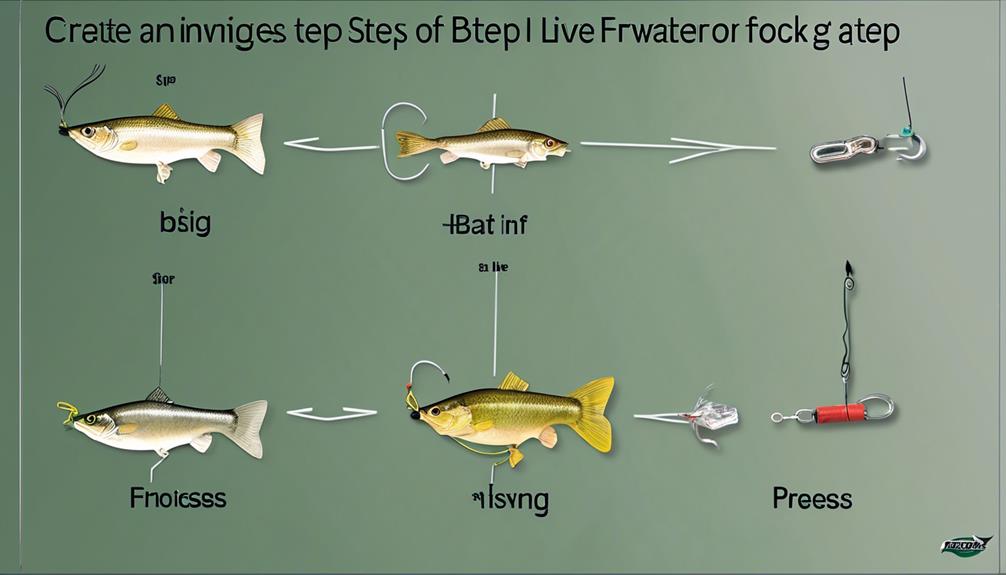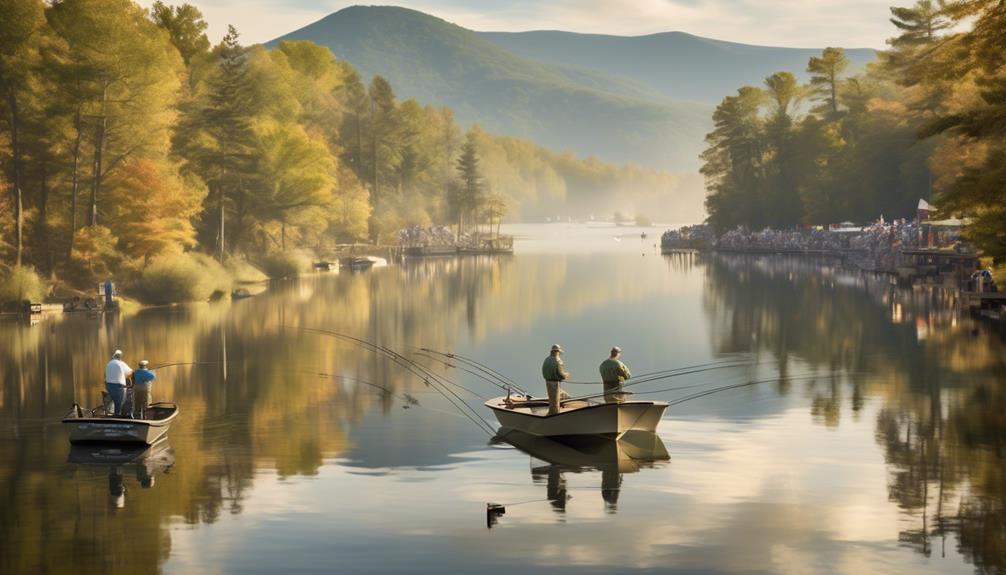Imagine yourself standing on the edge of a tranquil freshwater lake, the early morning mist rising from the water's surface as the sun begins to peek over the horizon. The thought of casting your line and waiting for the tug of a fish is both exciting and calming.
But where do you start as a beginner? What gear do you need? And how do you even begin to understand the behavior of the fish you're trying to catch?
In this discussion, we'll explore the fundamental steps that every freshwater fishing beginner should know. From terminology to techniques, by the end, you'll be well-equipped to embark on your first freshwater fishing adventure.
Understanding Freshwater Fishing Terminology
If you're new to freshwater fishing, it's essential to understand the terminology used in this popular recreational activity. When it comes to tackle selection, there are a few key terms you should be familiar with.
Tackle refers to the equipment used for fishing, including rods, reels, lines, and lures. Rods come in various lengths and actions, with shorter rods being suitable for small bodies of water and longer rods for larger areas. Reels are devices attached to the rod that hold the fishing line and allow you to reel in your catch. Lines vary in strength and thickness, with lighter lines typically used for smaller fish and heavier lines for larger species. Lures are artificial baits designed to attract fish, and they come in different shapes, sizes, and colors to mimic natural prey.
Now let's move on to bait options. Live bait, such as worms, minnows, and insects, is a popular choice among freshwater anglers. Artificial bait, including plastic worms, crankbaits, and spinnerbaits, can also be effective in attracting fish. Understanding the differences between these bait options and knowing when to use each can greatly improve your chances of success on the water.
Selecting the Right Fishing Gear
Now that you understand the terminology for tackle and bait options in freshwater fishing, it's time to focus on selecting the right fishing gear for your needs.
When it comes to fishing rod selection, consider the type of fish you'll be targeting. For beginners, a medium-action spinning rod around 6 to 7 feet long is versatile and easy to use. It provides a good balance between flexibility and strength, making it suitable for a variety of freshwater fishing situations. Additionally, pay attention to the rod's power, which refers to its lifting strength. Light power rods are suitable for smaller fish, while medium to heavy power rods are better for larger species.
Next, let's talk about bait and lure options. For beginners, a simple tackle box with a variety of hooks, sinkers, and bobbers is a good starting point. It's also beneficial to have a selection of artificial lures such as spinners, crankbaits, and soft plastics. Live bait options like worms, minnows, and crickets are also effective and easy to use for beginners. The key is to have a well-rounded selection to adapt to different fishing conditions and target various fish species.
When selecting your fishing gear, it's important to consider the specific requirements of the type of fishing you'll be doing and the fish you aim to catch. By choosing the right fishing rod and having a well-stocked tackle box, you'll be well-prepared for your freshwater fishing adventures.
Identifying Suitable Freshwater Fishing Locations
To maximize your freshwater fishing success, it's crucial to identify suitable fishing locations with ample fish populations and conducive environmental conditions. When considering freshwater fishing locations, it's important to take into account water conditions and seasonal changes.
Different fish species thrive in different water conditions, so understanding the water temperature, clarity, and flow of a particular location can help you target the right species. Additionally, seasonal changes can affect fish behavior and movement, so being aware of these patterns can greatly improve your chances of a successful fishing trip.
Local knowledge is invaluable when it comes to identifying suitable freshwater fishing locations. Local anglers or fishing clubs can provide insights into the best spots, the types of fish available, and the most effective techniques for each location. They can also advise on any specific regulations or restrictions that may apply.
Furthermore, utilizing online tools such as Google Maps can help you scout potential fishing spots from the comfort of your home. Pay attention to features such as underwater structures, access points, and nearby amenities when using these online resources.
Learning Basic Freshwater Fishing Techniques
When starting to learn basic freshwater fishing techniques, it's essential to focus on mastering fundamental casting and reel retrieval methods. Casting techniques play a crucial role in freshwater fishing. Practicing different casting methods such as overhead cast, sidearm cast, and pitching will help you cover more water and increase your chances of catching fish.
It's important to learn the proper way to select bait based on the type of fish you're targeting. Different fish species are attracted to different types of bait, so understanding their preferences is vital for a successful catch.
Additionally, understanding how to handle fish and release them properly is essential for the conservation of freshwater ecosystems. Learning proper fish handling techniques will minimize harm to the fish and increase their chances of survival upon release. When catching and handling fish, always ensure that your hands are wet to protect their delicate skin and scales.
Proper catch and release practices contribute to the sustainability of fish populations and the overall health of freshwater environments.
Understanding Freshwater Fish Behavior
Understanding freshwater fish behavior is crucial for increasing your chances of catching fish and contributing to the sustainability of fish populations and the overall health of freshwater environments. Fish feeding habits play a significant role in their behavior. Different species exhibit various feeding patterns, including herbivorous, carnivorous, or omnivorous tendencies. By understanding the feeding habits of the specific fish you're targeting, you can better select the appropriate bait and fishing techniques to attract them.
Habitat preferences also greatly influence freshwater fish behavior. Some fish prefer clear, shallow waters with plenty of vegetation, while others thrive in deeper, darker areas with more cover. By researching and understanding the habitat preferences of the fish you're targeting, you can effectively narrow down the areas where you're likely to find them. This knowledge helps you efficiently locate fish and increases your chances of a successful fishing trip.
Observing fish behavior in their natural environment also provides valuable insights. Take time to watch how fish move, where they gather, and how they respond to changes in their surroundings. This observational approach can offer critical clues about how fish are behaving on a particular day, enabling you to adapt your fishing methods accordingly.
Familiarizing With Freshwater Fishing Regulations
Before heading out for your freshwater fishing trip, it's essential to familiarize yourself with the local freshwater fishing regulations.
First and foremost, you need to ensure that you have a valid fishing license for the specific area where you plan to fish. Fishing without a license can result in hefty fines and penalties, so it's crucial to check the local requirements and obtain the necessary permits before casting your line.
Additionally, familiarize yourself with the catch limits for the area where you'll be fishing. Catch limits specify the maximum number of fish you're allowed to catch and keep within a certain period. These limits are put in place to conserve fish populations and ensure sustainable fishing practices. Exceeding catch limits can result in fines and negatively impact the local ecosystem, so it's important to adhere to these regulations.
It's also important to familiarize yourself with any specific regulations regarding the types of fish that are permissible to catch in the area. Some regions have restrictions on catching certain species in order to protect vulnerable populations or maintain a balanced ecosystem.
Basic Freshwater Fish Species Identification
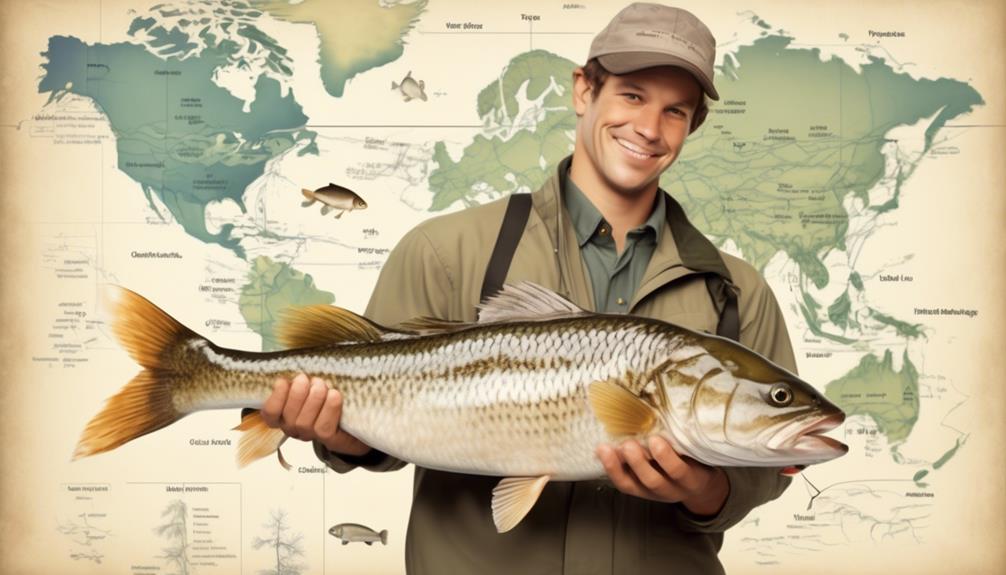
To identify basic freshwater fish species, familiarize yourself with the distinct physical characteristics and behavioral traits of each type, enabling you to recognize them during your fishing excursions. Understanding fish anatomy is crucial in species identification. Pay attention to details like the shape and size of the fish, the placement of fins, the coloration and patterns on their bodies, and the presence of specific features such as barbels or teeth.
Additionally, observe the behavior of the fish in their natural habitat. Different species exhibit unique behaviors, such as feeding patterns, preferred water depths, and movements. For example, largemouth bass are known to be aggressive predators and often linger near underwater structures, while trout are more likely to be found in fast-flowing, oxygen-rich waters.
Another way to identify fish species is to observe their feeding habits. For instance, carp are bottom feeders and often stir up sediment while feeding, while bluegill tend to feed near the water's surface. Understanding these behaviors will help you differentiate one species from another.
Furthermore, take note of the habitats where you find each species. Some fish prefer clear, shallow waters, while others thrive in murky, deeper areas.
Safety Tips for Freshwater Fishing Beginners
When you're out fishing for freshwater species, it's essential to prioritize safety on the water, ensuring a secure and enjoyable experience. Here are some safety tips and fishing etiquette to keep in mind:
Water Safety:
- Always wear a properly fitted life jacket, especially if you're fishing from a boat or near swift currents.
- Familiarize yourself with the water body you'll be fishing in and be aware of any potential hazards such as submerged rocks or sudden drop-offs.
- Keep an eye on the weather forecast and be prepared for changes in conditions. It's important to seek shelter if a storm approaches.
Fishing Etiquette:
- Respect other anglers' space by maintaining a reasonable distance between fishing spots.
- Properly dispose of any trash or fishing lines to help keep the environment clean and safe for both wildlife and other anglers.
Frequently Asked Questions
How Can I Properly Release a Fish Back Into the Water Without Harming It?
When releasing a fish, use fish-friendly hooks and proper fish handling techniques. Follow catch and release techniques to ensure the fish's safety. It's important to practice ethical fishing practices to contribute to fish conservation efforts.
What Are Some Common Mistakes That Beginner Freshwater Fishermen Make and How Can I Avoid Them?
Common mistakes like using the wrong bait or not checking the weather can hinder your fishing trip. Avoidance tips include researching the best time to fish and learning proper catching techniques to improve your success.
Are There Any Specific Techniques for Catching Different Freshwater Fish Species, or Can I Use the Same Approach for All of Them?
When catching different freshwater fish species, it's key to use specific techniques. Each species may respond differently to bait selection and catching tips, so it's important to tailor your approach to the specific fish you're targeting.
What Are Some Important Factors to Consider When Choosing the Best Time of Day to Go Freshwater Fishing?
When choosing the best time of day for freshwater fishing, consider weather conditions and best fishing spots. Look for areas with shade, structure, and potential feeding areas. Pay attention to wind direction and cloud cover for optimal conditions.
How Can I Effectively Clean and Prepare the Fish I Catch for Cooking?
To effectively clean and prepare the fish you catch for cooking, start by scaling and gutting the fish. Then fillet or cook it whole using your preferred cooking techniques. For fish preservation, consider using storage methods like freezing or vacuum sealing.
Conclusion
Now that you've learned the basic steps for freshwater fishing, it's time to hit the water and put your newfound knowledge to the test.
Remember to stay safe, follow regulations, and respect the environment as you enjoy your fishing adventures.
With practice and patience, you'll soon become a confident and successful freshwater angler.
Good luck and tight lines!
